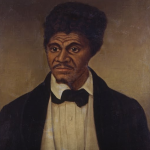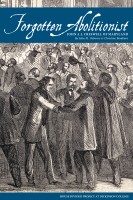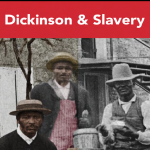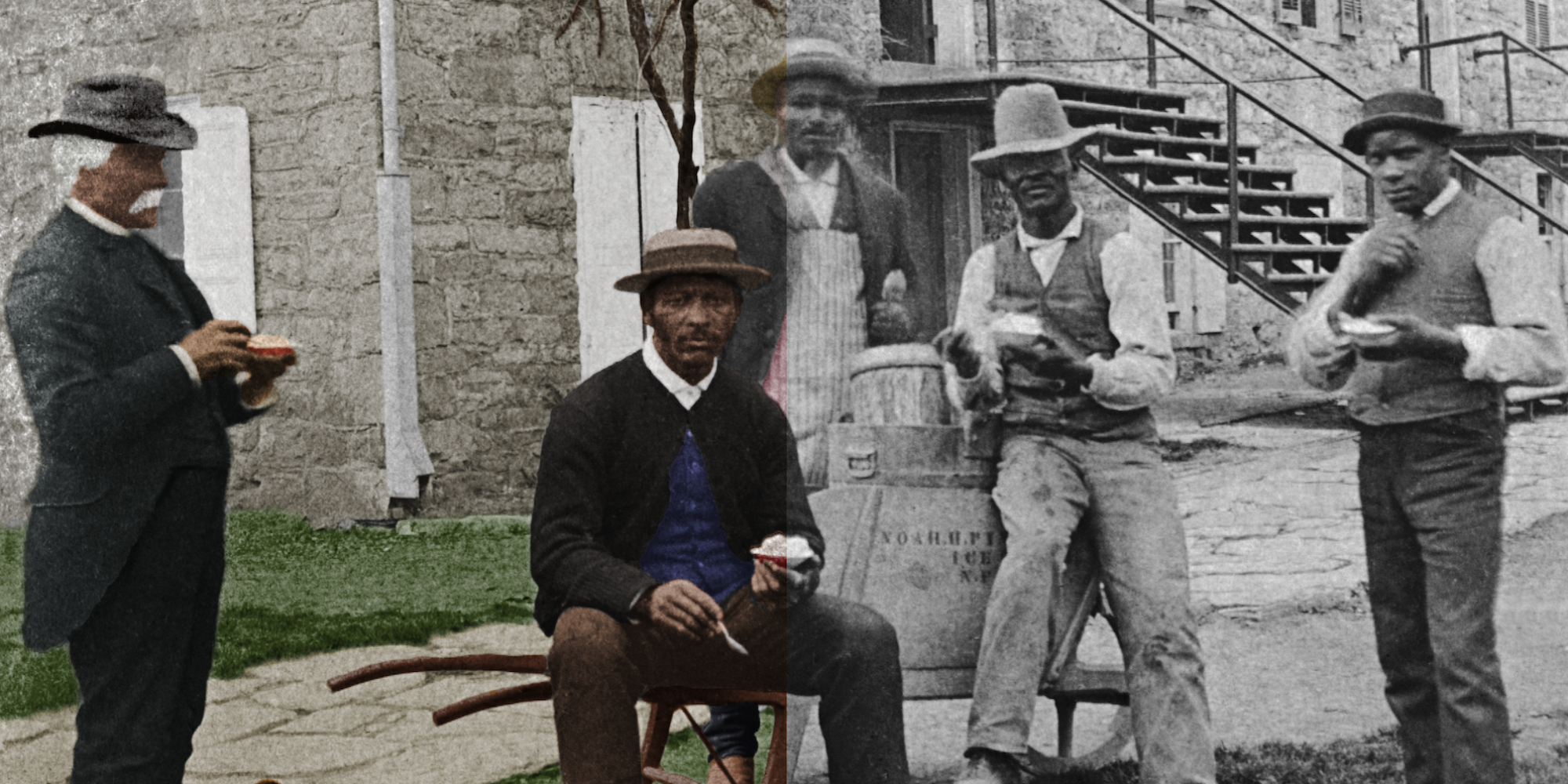Report
In August 2019, we completed a 35-page report on Dickinson & Slavery with a set of recommendations for the community on how to improve the commemoration of this important subject. In October 2019, the President’s Commission on Inclusivity endorsed these recommendations. In December 2019, Dickinson College President Margee Ensign authorized the creation of an Ad Hoc Committee on Renaming to consider implementation plans for these measures for final consideration by the Board of Trustees in 2020.
- Download for free || 2019 Dickinson & Slavery Report
Discussion Roundtables
As part of our effort to encourage deeper engagement with this history, we have begun encouraging faculty and students at Dickinson to write down reflections on some key question raised by our research. How should we characterize the relationship between nineteenth-century students and their college janitors? If the college does rename a building such as Cooper Hall, which nineteenth-century figure should receive such an honor? Was the prejudice which black residents of Carlisle encountered after the Civil War an illustration of “Jim Crow North” or does it deserve a different designation? Our first open discussion topic for 2019 concerns memorialization on campus.
- How Should We Remember(2019)
- Suggestions from History Students (2023)
Lesson Plans
How should classroom teachers at the secondary and undergraduate levels approach topics such as the ones raised by the Dickinson and Slavery initiative. Over the years, the House Divided Project has cultivated a network of thousands of K-12 educators from across the country. We asked some of them to contribute lesson plans specifically designed to bring material from this website to life in a classroom setting. We have also gathered together some of the best examples of slavery-related lesson plans created in the past by our teacher participants in workshops and online courses.
Recent Publications
 In 2009, House Divided project director Matthew Pinsker edited a pamphlet on the Dred Scott Decision with staff from the Gilder Lehrman Institute of American History. The pamphlet includes images and documents from the GLC collection, as well as a helpful timeline and readable introduction to the infamous 1857 decision produced from the chambers of Dickinson graduate Chief Justice Roger B. Taney. Download for free || Citizen or Slave: The Dred Scott Decision, 1857
In 2009, House Divided project director Matthew Pinsker edited a pamphlet on the Dred Scott Decision with staff from the Gilder Lehrman Institute of American History. The pamphlet includes images and documents from the GLC collection, as well as a helpful timeline and readable introduction to the infamous 1857 decision produced from the chambers of Dickinson graduate Chief Justice Roger B. Taney. Download for free || Citizen or Slave: The Dred Scott Decision, 1857
 In 2015, librarian Christine Bombaro and project co-founder John Osborne co-authored the first e-book in the House Divided publication series on “forgotten abolitionist” John A.J. Creswell of Maryland. Creswell, a Dickinson graduate, was a Unionist politician who helped spearhead the 1864 state referendum to abolish slavery in Maryland. He then led off the final congressional debates for the Thirteenth Amendment in 1865 and became a civil rights advocate as US postmaster general during Reconstruction.
In 2015, librarian Christine Bombaro and project co-founder John Osborne co-authored the first e-book in the House Divided publication series on “forgotten abolitionist” John A.J. Creswell of Maryland. Creswell, a Dickinson graduate, was a Unionist politician who helped spearhead the 1864 state referendum to abolish slavery in Maryland. He then led off the final congressional debates for the Thirteenth Amendment in 1865 and became a civil rights advocate as US postmaster general during Reconstruction.
Download for free || Forgotten Abolitionist: John A.J. Creswell of Maryland
 In 2017, history professor Christopher Bilodeau penned a wide-ranging reflection on college founder Benjamin Rush’s complicated ideas about race. Rush was widely known as one of the county’s leading opponents of slavery –and yet he spent a lifetime surrounded by enslaved people. Rush owned at least one of these household servants, a man named William Grubber, whom he took an especially long time to emancipate. Bilodeau’s essay appeared in the fall issue of the Dickinson Magazine. Read for free || Thinking With Benjamin Rush
In 2017, history professor Christopher Bilodeau penned a wide-ranging reflection on college founder Benjamin Rush’s complicated ideas about race. Rush was widely known as one of the county’s leading opponents of slavery –and yet he spent a lifetime surrounded by enslaved people. Rush owned at least one of these household servants, a man named William Grubber, whom he took an especially long time to emancipate. Bilodeau’s essay appeared in the fall issue of the Dickinson Magazine. Read for free || Thinking With Benjamin Rush
 On February 1, 2019, the House Divided Project launched a new exhibit on Dickinson & Slavery inside its studio on 61 N. West Street in Carlisle. The exhibit covers the sweeping story of more than 150 years, from when hAfrican Americans participated in the shaping of college life during the eighteenth century as slaves hired out to help build the campus all the way to the late nineteenth century and early twentieth century when the children of former slaves helped integrate the school as students. Read for free || Exhibit Catalog
On February 1, 2019, the House Divided Project launched a new exhibit on Dickinson & Slavery inside its studio on 61 N. West Street in Carlisle. The exhibit covers the sweeping story of more than 150 years, from when hAfrican Americans participated in the shaping of college life during the eighteenth century as slaves hired out to help build the campus all the way to the late nineteenth century and early twentieth century when the children of former slaves helped integrate the school as students. Read for free || Exhibit Catalog
College Histories
With roots as an educational institution dating back to 1773, Dickinson College has had more than its share of official and unofficial histories. However, the subject of slavery almost never gets mentioned in any of these publications. The first notable instance comes from Horatio Collins King in his 1897 history of the college, which mentions John Nevin, a now-obscure man who graduated with Roger B. Taney (Class of 1795) and whom King identifies (incorrectly) as “author of the first anti-slavery publications in this country.” McAlarney’s brief speech in 1904 describes a beloved campus tradition of “Spradley’s dinners” (Henry W. Spradley was a former slave from Virginia who served as janitor and bell ringer in Old West from the late 1870s to the 1890s), but otherwise provides little context for understanding the role of ex-slaves at Dickinson. The most comprehensive modern history of the college (Sellers, 1973) covers several aspects of the sectional debates over slavery and how they affected students and faculty, but provides almost no details concerning any individuals who were actually enslaved. In other words, despite decades of general historical inquiry, the subject of Dickinson College’s ties to slavery and antislavery has remained essentially unexplored until now.
- A Sketch of the Rise, Progress and Present State of Dickinson College (1811)
- Charles Collins, Dickinson College (1856)
- Dickinson College and Its Alumni (1866)
- William Allen, Dickinson College: An Historical Sketch (1875)
- Charles Francis Himes, A Sketch of Dickinson College (1879)
- Horatio Collins King, History of Dickinson College (1897)
- Robert McAlarney, Address on the History of West College (1904)
- Edward W. Biddle, The Old College Lot (1920)
- Charles W. Super, A Pioneer College and Its Background (1923)
- James Henry Morgan, Dickinson College (1933)
- Charles Coleman Sellers, Dickinson College: A History (1973)
In some important ways, recent digital projects and online posts from the college offer more material directly connected to the slavery question than any of the earlier print histories.
- James Gerencser & John Osborne, eds., Dickinson College Chronicles (2000)
- James Gerencser, ed., Dickinson Archives & Special Collections (current)
- Matthew Pinsker, ed., House Divided Project at Dickinson College (current)
- Dickinson College, “The Dickinson Story,” “Benjamin Rush,” (current)
Press Releases & Media Coverage
- Sep. 12, 2010: Descendants of Black Soldiers Gather at Dickinson
- Feb. 19, 2014: Atlantic Slave Trade Mosaic
- March 24, 2016: Foner Headlines Reconstruction Conference
- Sep. 27, 2016: Student Authors Book on Underground Railroad
- Oct. 1, 2016: New E-Book on Forgotten Abolitionist
- Nov. 15, 2016: Students Opposing Slavery Honored at White House
- April 25, 2017: Dickinson Hosts Northern Premiere of Lynching Film
- Sep. 17, 2018: Constitution Day Panel on Fugitive Slave Law
- Nov. 1, 2018: New Project on Slave Stampedes
- Jan. 30, 2019: Dickinson College Joins Universities Studying Slavery (UVA)
- Jan. 31, 2019: Exhibit Delves into Complicated History with Slavery (Carlisle Sentinel) [PDF]
- Feb. 1, 2019: Open House for Dickinson & Slavery Exhibit
- Feb. 1, 2019: Project Tells Forgotten Story of Slavery
- March 22, 2019: Dickinson’s Connection to Slavery (WITF “Smart Talk”) with PODCAST
- March 23, 2019: Teacher Workshop on Slavery
- March 23, 2019: Open House Features Rare Relics
- March 23, 2019: Coleman to Speak from Gettysburg Lectern
- March 28, 2019: Dickinson’s History With Slavery and Cooper Hall (Dickinsonian)
- April 8, 2019: Dickinson Slavery Project Could Lead to Renaming (Sentinel)
- May 10, 2019: Carlisle Borough Council Notes: Remembering History (Sentinel)
- July 15, 2019: National History Academy Explores House Divided (Sentinel)
- Dec. 13, 2019: Report for Dickinson & Slavery Reaches Community
- Dec. 13, 2019: Dickinson College Should Purge Names (Patriot-News)
- Dec. 13, 2019: Report Recommends Renaming (Carlisle Sentinel)
- Dec. 16, 2019: Cincinnati, Dickinson Reevaluate Ties with Slave Owners (Inside Higher Ed)
- Jan. 20, 2020: Three Buildings May Be Renamed (Fox43)
- May 6, 2020: Dickinson Begins Diversifying Campus Memory
- June 26, 2020: Historical Parallels to Andrew Johnson (WITF)
- July 24, 2020: Monument Movement: Confederate Controversy (Sentinel)
- July 26, 2020: Monument Movement: Who is Missing? (Carlisle Sentinel)
- March 31, 2021: New Dickinson & Slavery Walking Tour
- April 7, 2021: Dickinson College Adds New Markers (ABC27)
- April 7, 2021: Dickinson Acknowledges History of Slavery (CBS21)
- April 7, 2021: Dickinson Historic Walking Tour (Fox43)
- April 7, 2021: Dickinson Unveils Walk Exploring Slavery (Carlisle Sentinel)
- April 7, 2021: Dickinson Adds Context To Its History (PennLive)
- Nov. 8, 2021: Students, Descendants Reflect on name Changes (ABC27)
- Nov. 17, 2021: Dickinson College to Rename Campus Spaces (Fox43)
- Nov. 19, 2021: Former Slaves Made an Impact (WITF)
- Nov. 20, 2021: Special Nov. 20th Events (House Divided)
- Nov. 21, 2021: Dickinson Honors Former Slaves (Fox43)
- Nov. 21, 2021: Honoring Inspiration (Carlisle Sentinel)
- Nov. 21, 2021: Transcripts of Student Speeches (Carlisle Sentinel)
- Nov. 21, 2021: Dickinson College Renames Campus Spaces (PennLive)
- Nov. 21, 2021: Dickinson Officially Renames Residence Hall (ABC27)
- Nov. 21, 2021: Renaming Ceremony (with photos) (Dickinson)

